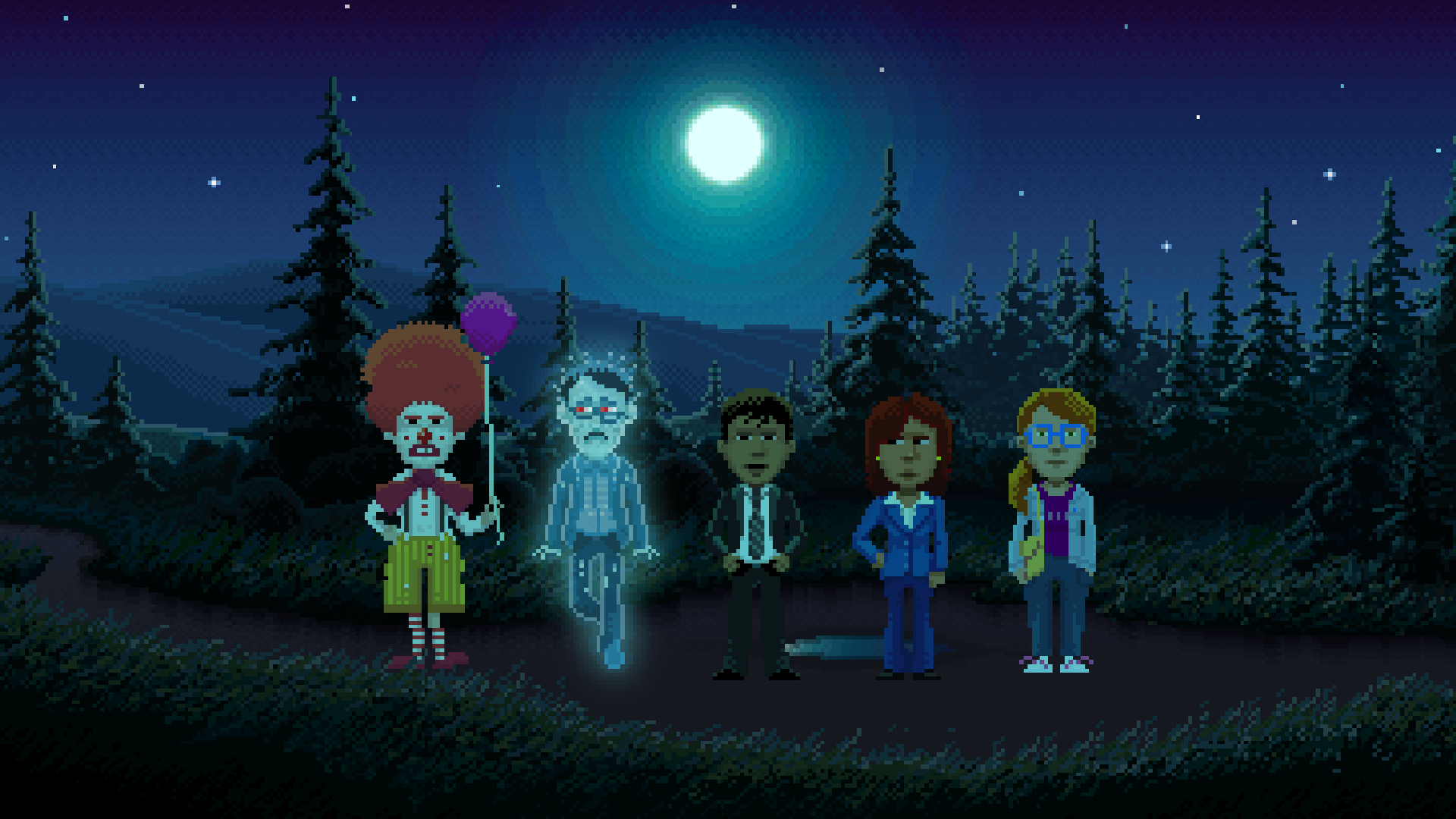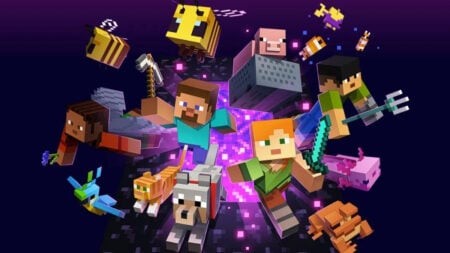Title: Thimbleweed Park
Available On:
Developer: Terrible Toybox
Genre: Point And Click Adventure
Official Site: Thimbleweed Park
Release Date: March 30th, 2017
Where To Buy:
Thimbleweed Park recaptures my childhood. The first genre of gaming I recall playing is the point and click adventure series with titles such as Maniac Mansion and the Monkey Island series. It should be no surprise then that Thimbleweed Park drew me in. The developer Terrible Toybox is headed by the industry pioneer Ron Gilbert who is responsible for the previously mentioned masterpieces. Thimbleweed Park does not gesture a simple nod to its predecessors but picks up the genre right where it left it. Full of hilarious witty dialogue, ludicrously tricky puzzles and more meta references than Deadpool. Thimbleweed Park’s biggest appeal is that it feels retro in a age where in gaming, guns can speak louder than words.
Thimbleweed Park arrives in a time of nostalgia. We’ve seen TV shows returning from huge absences, old fashion crimes have materialised on trendy hipsters and a new Star Wars trilogy is in development. South Park captured the essence of nostalgia perfectly with the introduction of sweet, delicious Member Berries. When we look back at these significant moments in pop culture we see them with clouded vision and more often than not, their reintroduction to our lives are disappointing. Occasionally however, sentimentality is precisely what we need and Thimbleweed Park is just that.
The nostalgia begins immediately as forgotten memories of Monkey Island come flooding back as I’m asked to choose between casual or hard mode; the latter being the only way to play Thimbleweed Park in my opinion. I was surprised to see a tutorial of sorts yet in evocative style, you are treated to a PowerPoint looking slide-show. Circled overlays describe the basics which incidently is all you need to know to enjoy Thimbleweed Park. For anyone who has never played a classic point and click adventure, you have 9 verbs such as ‘pick up’ and ‘talk to’ and a ever growing inventory. Aside from logic, curiosity and imagination; the entirety of Thimbleweed Park relies on these mechanics. This allows the story, writing and characters to take centre stage and shine.

Thimbleweed Park begins with you essentially assisting your own murder. Your character has been lured to a shady meeting point and told not to bring any identification or evidence that would be useful for authorities. He believes the situation to be harmless yet the player knows otherwise. This meta-humour fuels Thimbleweed Park which allows for a broad range of comedy throughout. Inevitably, our character is killed and we soon take control of our actual protagonists, Agent Ray and Agent Reyes. The two are polar opposites of one another as Ray is a veteran in her department who, as a female in 1987, maybe missing out on opportunities because of her sex. Reyes on the other hand is the younger, enthusiastic newbie trying to make a name for himself. The contrast between the two balances out beautifully and although at times you will have to play as both, you can favour one if you so choose.
The two agents must first identify the body which begins the huge mystery within Thimbleweed Park, a small rundown town which used to be a vibrant locale due to the famous pillow factory. As the game is set in the 80’s, technology is slightly dated and identifying the corpse is no easy task. Using a Polaroid camera by exchanging film between the characters, the game demonstrates one mechanic. A meta-reference of describing the body as beginning to ‘pixelate’ sets the tone. Within the first 10 minutes you will know if you are going to enjoy Thimbleweed Park and I could not wait to continue my adventure.

The standout quality of the prior games in the genre and particularly Thimbleweed Park is the writing. Every sentence has purpose be it informative, funny or foreboding. As a child, I always found the legendary pirate LeChuck in Monkey Island terrifying. Thimbleweed Park succeeds is finding a weighted balance between comedy and an ominous atmosphere. The derelict town feels creepy and exploring cemeteries and dark alleys adds to the tone. The musical score is brilliantly composed and captures each setting perfectly. The murder mystery remains throughout and short clips of a camera watching your movement between acts keeps you on edge. This tension is alleviated by many characters breaking the fourth wall. One character, while taking a jab at other developers of the time, alludes to this safe yet edgy ambiance being created in Monkey Island.
References to past games, other developers and other satirical comments are the soul of Thimbleweed Park. You will find jokes aimed at the now defunct Lucasarts studio, referred to as MMucasflem. Sierra Games, a competitor in the 80’s and 90’s suffers a few friendly jibes and even the industry as a whole is not free from scorn. Ron Gilbert was famous for these references thirty years ago and since then, they have only grown more poignant and relevant.
The main reason why the scripting is compelling is because it does not just serve a purpose to progress the plot. To complete Thimbleweek Park it took me nearly twenty hours. Dialogue is essential for completion but I also spent hours simply conversing. You will encounter some odd personalities in the town including a sheriff who strikes an uncanny resemblance to the coroner and the hotel manager. The difference between them is the amusing mannerism of the official adding “a-reno” to every sentence whereas the doctor will slip in “a-who”. The protagonists have a multitude of questions and replies for all conversations and I adore the ones that serve no purpose other than amusing the player. Asking a robot to name the laws of physics is a totally irrelevant question but how else would you find out that the third law is “to party like it’s 1999”? These outlandish replies offer more questions and you can delve deeper into the conversation. I drank from a water fountain for over a minute making a wide variety of slurping sounds just for the fun of it.
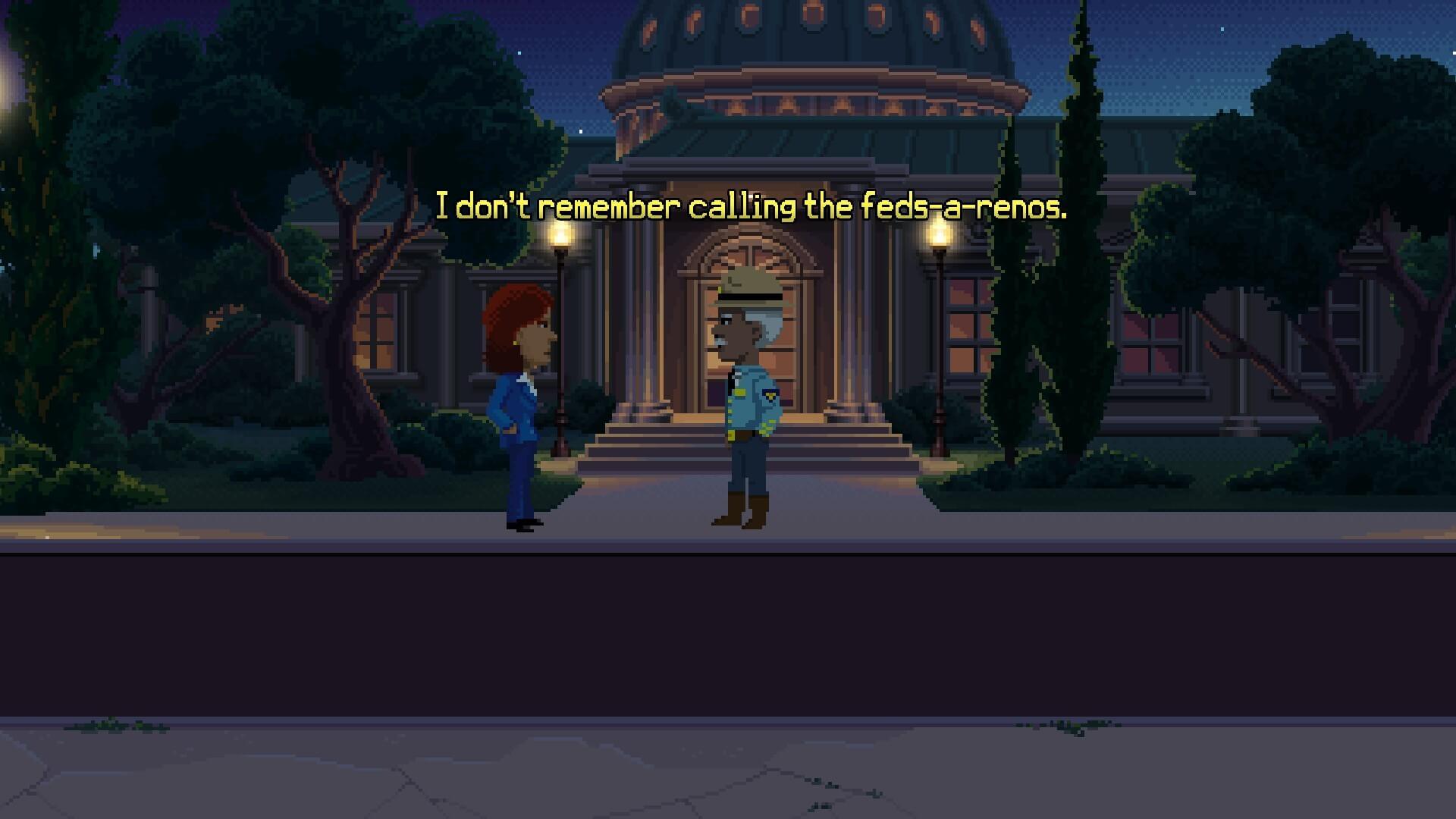
Aside from the two agents, you will gain control of other character residing within Thimbleweed Park. You are introduced to them via flashbacks as possible suspects but soon have the ability to control them in the present timeline as well. One such character is Dolores who has ambitions of becoming a game developer and many in-jokes arise from this career choice. She also has a very significant relationship to one of the key characters within the town. Another character you will control, and could be the best character in the game, is Ransom the Clown. Unlike most clowns who can be mute and to some, funny… Ransom’s act is to insult everyone he meets in the most offensive way possible. The first time you see his show, he insults a disabled gentleman, a moustached man and lastly, a old lady with a hairy mole. The final victim turns out to be a huge mistake as Ransom is cursed to resemble a clown for the rest of his life. This jinx only makes Ransom more comical for the audience as he becomes even more bitter. Every other sentence will contain a bleeped expletive and playing as Ransom, I always had a huge satisfying smile on my face.

This range of personalities should amass to some brilliant interactions between one another but sadly, this never happens. A brief exchange happens between the agents and additional characters but this simply serves to introduce them to your roster. Oddly, you are unable to initiate a conversation between them and when you trade inventory items, aside from an amusing quip, there is no logic for the transaction. Even more frustrating is the inability to trade items on the fly. Instead you have to both travel to the same location and although this seems logical, in the tougher parts of the game where you are looking for leads to progress the story, it can make the already tough puzzles tedious. It is not until the final acts that our heroes combine their agendas and work together but it feels like a missed opportunity considering how strong all of their identities are.
Ron Gilbert and the team utilize their prior work on Maniac Mansion as more characters become available to you. Occasionally certain protagonists will be unusable but you always have at least two at your disposal. This dynamic is integral to the puzzles as areas and tasks are restricted to certain people. Dolores for example is the only party member allowed to visit the ‘Mansion Mansion’ (another pun) whereas Ransom can gain membership to an underground conspiracy agency. At times, five characters will be playable and Thimbleweed Park can become extremely daunting. Each have their own notebook listing their tasks which leads you in the right direction but at times, you will feel dumbfounded. Normally you know what you need to do but achieving that requires a unorthodox method. It took me nearly ten minutes to ignite a fireplace which needed to be done by consuming some extra hot sauce. I love these conundrums but newcomers be warned.
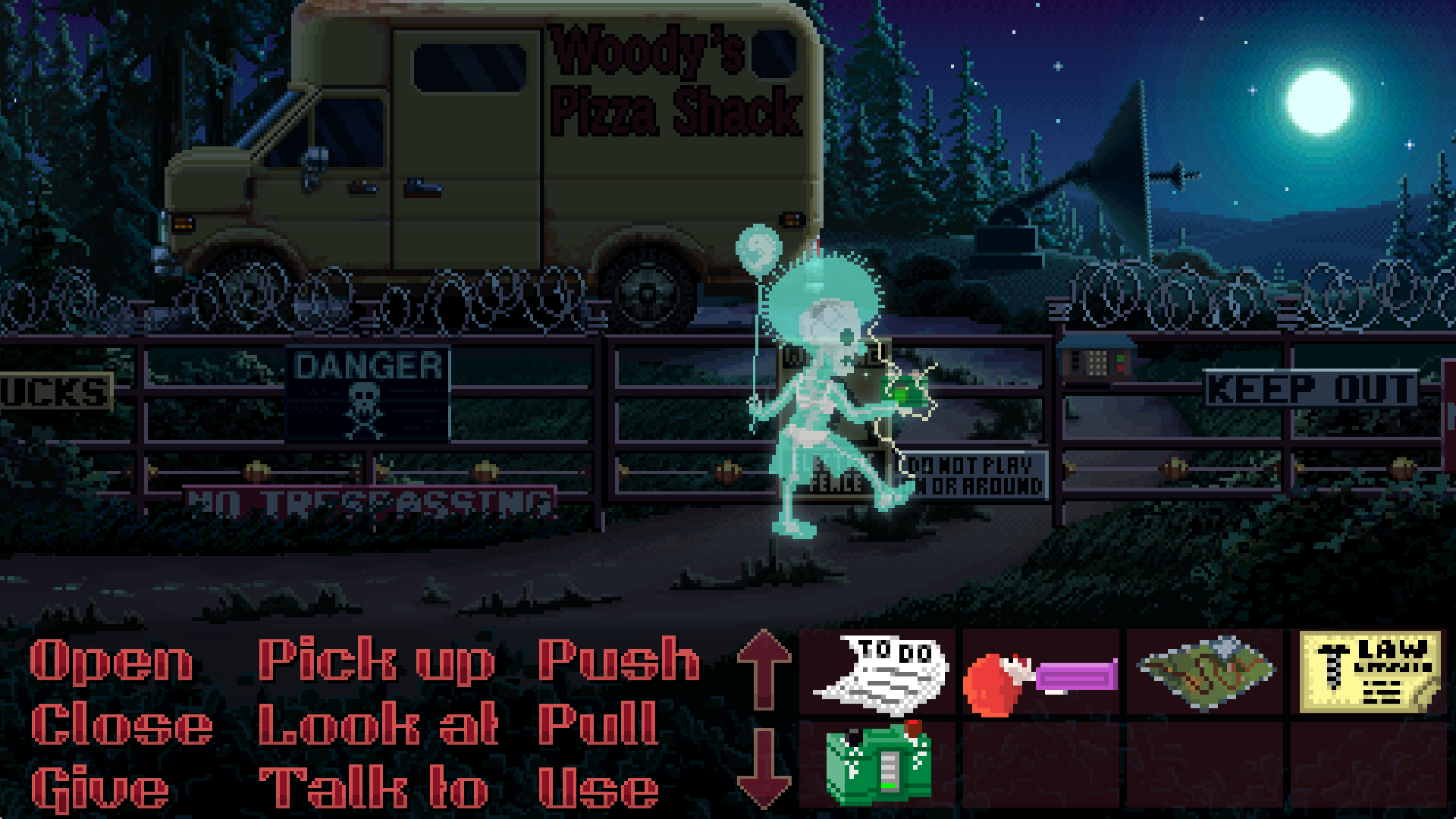
As a first timer to the genre, Thimbleweed Park can be alienating. Small details such as the notebook, fast travel and voice acting have been added, but on the whole, Thimbleweed Park looks as though it was made in the early 90’s. Characters have overly large pixelated heads and your inventory will have small animations such as a snake jumping out of a box. There is an undeniable charm to the aesthetics though as moonlit vistas look mesmerising and interiors become busy, exciting environments. Even the fast travel map looks like a 8-bit graphic just as it used to and be sure to acquire a map for each character, you will thank me later. Thimbleweed Park resides in a time when games were harder. My advice is to pick up everything, speak to everyone and attempt the ridiculous as it might just work.
Veterans will be warmly welcomed by the game and supporters from the Kickstarter campaign even more so. You can make phone calls in game and just like conversations, some will progress the plot whereas the majority exist just to be enjoyed. The phone book is full of contact numbers and each of these leads to a unique voicemail left by a backer. At the mansion, there is a library with hundreds of books and once again, the people who supported the game were able to contribute their own literature. You could potentially spend days browsing through odd self-help books or creepy stories. It is a wonderful gesture to fans and had me wishing I had supported the game from the start!
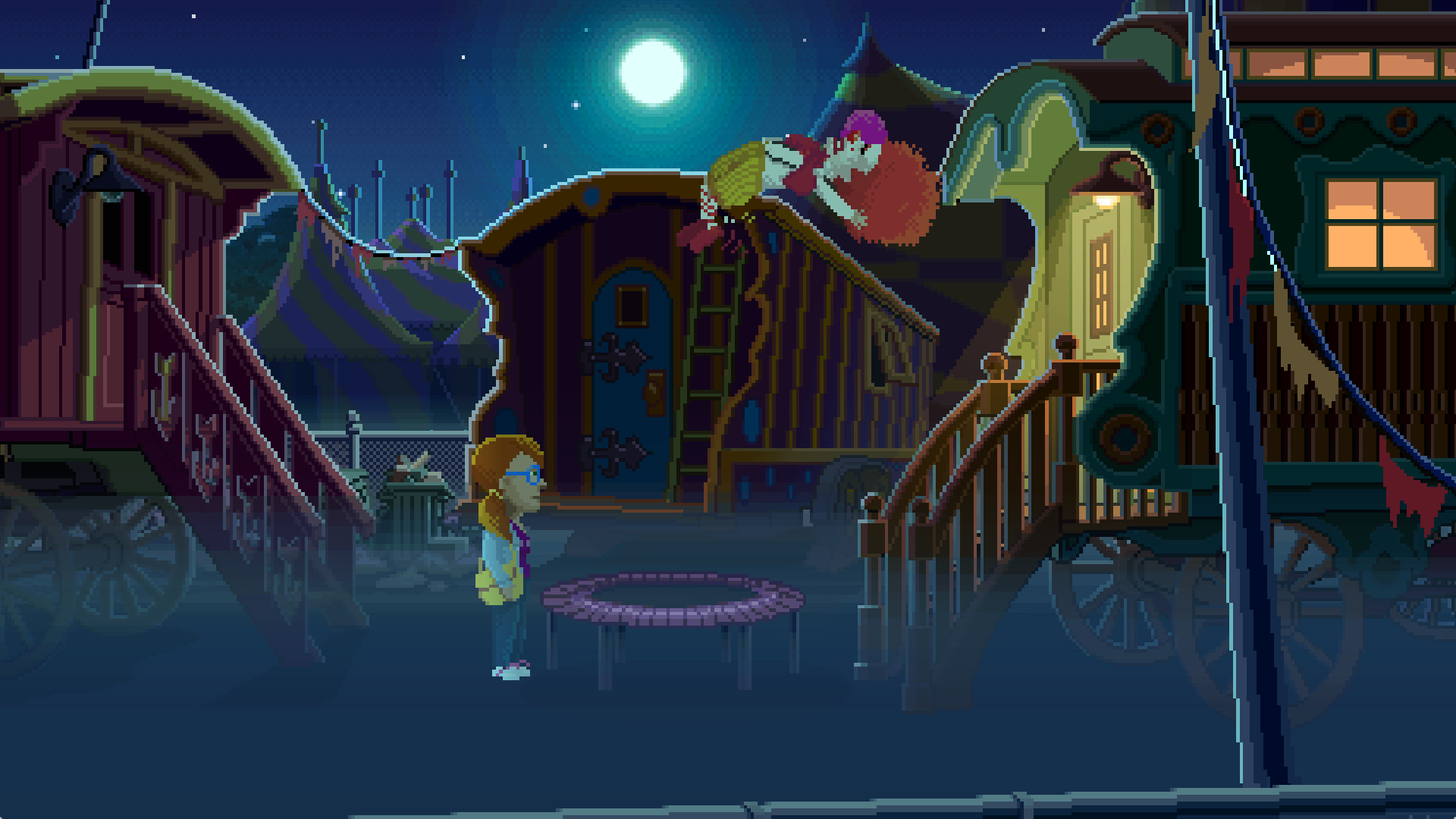
The puns, jokes and references would mean very little if at the core of Thimbleweed Park there was not an interesting plot driving proceedings forward. The game is split into a number of acts and each begins after a significant event. Flashbacks and unexpected scenes keep the mystery going yet even when I felt I knew where the plot was heading, the twists kept coming. The finale is inspired by a very famous film and the parody within Thimbleweed Park may actually be better than the source material. Each character receives closure to their story and I found myself wanting to put off the final moments, much like the character in game.
We often crave to relive moments from our past and Thimbleweed Park gave me that opportunity. In a gaming age where graphics are recognised as a defining attribute to how good a game is, story and writing sadly can come second. Cult classics such as Maniac Mansion and Monkey Island introduced me to the world of gaming. Having the chance to experience a new story from the team behind those is an opportunity I did not think would arise. Thimbleweed Park is a shining example of why Kickstarter can be a great thing. If Thimbleweed Park is your first foray into the point and click adventure game, persist with it and you will be greatly rewarded. To the oldies, welcome back.
- Gameplay: Classic Verb Based Point And Click Adventure
- Graphics: Pixel Art Straight Out of The 90’s
- Sound: Brilliant Voice Acting and Soundtrack
- Presentation: A Homage To Origins And Fans
[review]

